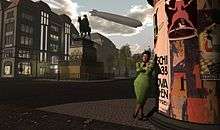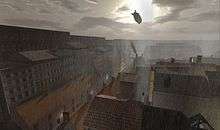The 1920s Berlin Project




The 1920s Berlin Project is a historical role-playing community in Second Life.[1] It is a sim game intended to simulate daily life in Berlin during the Weimar Republic and give the appearance and feel of authentic 1920s Weimar culture. It is a form of living history, performed in a virtual world using avatars.
Features
The neighborhood shows a wide range of buildings, some exact replicas of real buildings, such as the exclusive Hotel Adlon, Berlin Alexanderplatz station, the Zum Nußbaum inn and the Brandenburg Gate. There are also fictional buildings in the architectural style of the time, such as the large Bauhaus-style apartment block in the city.
There are many realistic signs and posters hanging on the city's walls, and visitors are expected to wear period clothing and behave in period appropriate ways. The neighborhood includes tiny apartments, shops, a cinema where people can view real 1920s movies, school, hotel and night club called Der Keller where people can listen to original 1920s music.
Several participants "live" in local apartments, and have virtual jobs. Though there are many English-speaking visitors and residents present, several other languages are regularly spoken within the city. It is, however, common for residents and visitors to use German phrases to greet one another, regardless of preferred language.
The simulation has rules for all visitors. People should dress in 1920s period style (free 1920s clothes are provided), the laws must be obeyed, and if you harass other visitors, you risk being banned. Nazi simulation is generally not allowed as it is against the Terms of Service of Second Life but also because in 1929, the Nazis were not yet that big a part of daily life in this city. A Dress code is strictly enforced in this world and failure to comply will risk ejection from Berlin. The idea is to see that all visitors and inhabitants feel as though they belong to the time period. In the entrance square, where visitors arrive by teleportation, there are free clothing boxes which allow avatars to change into virtual period costume.
The project is known for its arts and entertainment. Der Keller Tanzlokal (Bar), The Babylon cinema, Cabaret Eldorado (based on a real 1920s club for gay people and cross dressers), The Odeon Theatre and The Hindenburg Schule all boast either educational activities, films, dancing, lectures or live entertainment.
A very popular and active place is Der Keller, a bar located in a basement, in one of the city’s back alleys.
Most people gather at 2pm Second Life time to "drink" at the bar, chat and dance with others. In Der Keller, anyone can dance the Charleston and most are willing to join in on the fun. In the The Babylon cinema, a cartoon, newsreel and feature film are shown. Cinema in Germany was “an opportunity and temptation". The fact that an audience "member could sit in front of film screen and be enshrouded in darkness, made intimacy sociable and expanded the idea of unfamiliar identities.” [3] "German Expressionism was taking root in film and eventually influenced American Film Noir."[2]
The 1920s Berlin Project has been expanding and is continuously keeps being updated. Starting small, it has managed to pay for its own upkeep almost since the very beginning, regardless the high costs of virtual land, especially thanks to the tenants who live in the sim, supporters and random donations from visitors. The more than 80 residences in the city are almost always occupied and recently new land was added to the sim where people could live; this new area is called Tiergarten.
In March 2013, The 1920s Berlin Project was the subject of an episode of machinima documentary series The Drax Files: World Makers (Episode 2: Jo Yardley)
In March 2016, well known machinima maker Pepa Cometa made a short video about the 1920s Project, it was seen by over 10.000 people in a few days and has been mentioned by the media, including being shown on German tv show 'Volle Kanne'.
In May 2016 the project celebrated its 7th anniversary.
Jo Yardley, creator and manager of the project, has plans for more historically-themed role playing sims.
In September she started work on Time Portal, a non role playing sim with a time travel theme. Visitors arrive at a Time Machine and can visit several historical periods where they can explore, shop or live.
References
- ↑
- ↑ Berlin's Public Space in the 1910s and 1920s/Flickinger,Brigitte/Film Studies,Issue 10/2007/74,82
External links
- https://1920sberlinproject.wordpress.com Official website
- https://www.facebook.com/1920sberlinproject Facebook page
- http://www.flickr.com/groups/20sberlin/ Flickr group
- http://draxtor.com/2013/03/the-drax-files-go-to-1920s-berlin/ Drax files visits 1920s Berlin, with video
- https://vimeo.com/160288042 Machinima video made by Pepa Cometa
- https://modemworld.me/2016/05/30/1920s-berlin-project-celebrates-7-years-in-second-life/ article about 7th anniversary of 1920s Berlin's 7th anniversary by Inara Pey.
- http://thecreatorsproject.vice.com/blog/somebody-meticulously-recreated-1920s-berlin-in-second-life The Creators Project; 'Somebody Meticulously Recreated 1920s Berlin in Second Life'
- https://killscreen.com/articles/you-can-visit-a-historically-accurate-1920s-berlin-in-second-life/ You can visit an historically accurate 1920 Berlin in Second Life.
- http://strawberrysingh.com/2014/01/11/weekly-roundup-friday-find-the-1920s-berlin-project/ Weekly Roundup & Friday Find: The 1920s Berlin Project
- http://www.zdf.de/ZDFmediathek/kanaluebersicht/aktuellste/168#/beitrag/video/2717376/%22Volle-Kanne%22-ab-ins-Netz TV show 'Volle Kanne' mentions the 1920s Berlin Project.
- http://strawberrysingh.com/2015/07/14/i-met-dr-phil-in-second-life/ Tv host Dr. Phil visits the 1920s Berlin Project for his show.